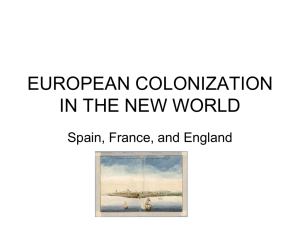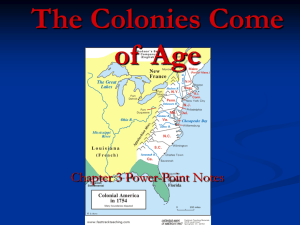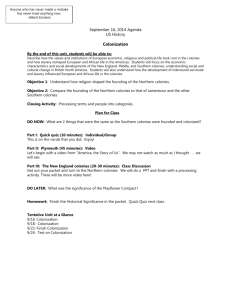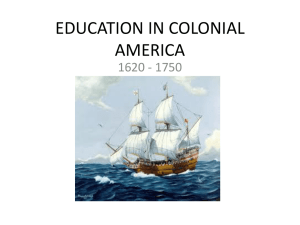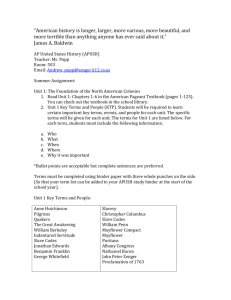UNIT 1 – EXPLORATION and COLONIZATION
advertisement
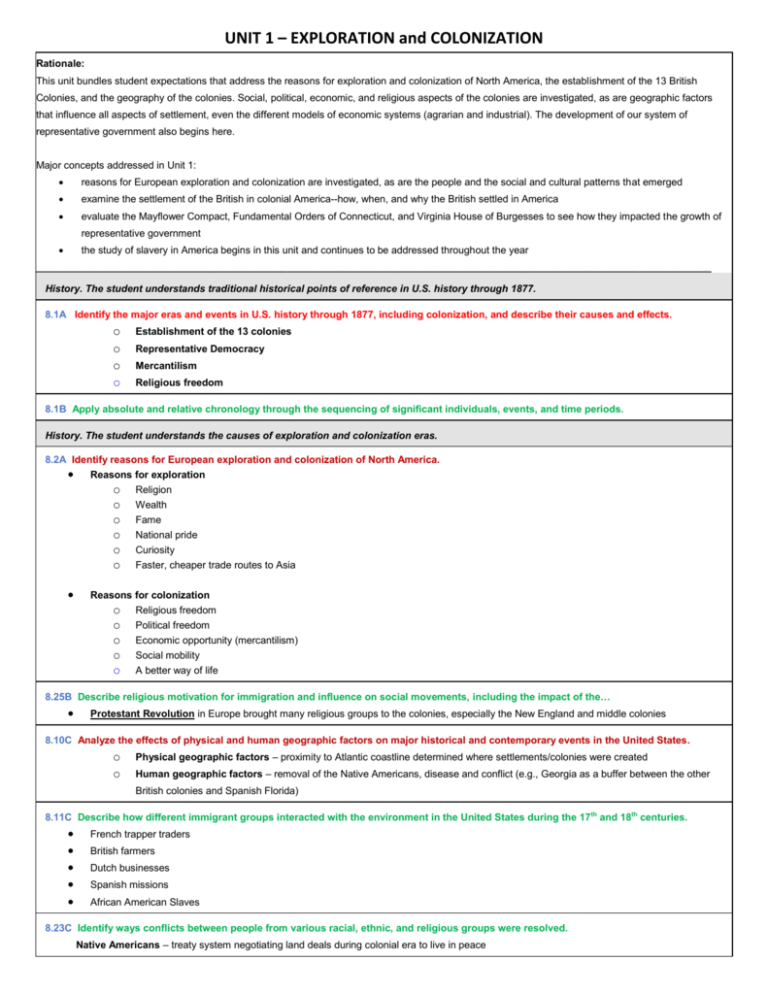
UNIT 1 – EXPLORATION and COLONIZATION Rationale: This unit bundles student expectations that address the reasons for exploration and colonization of North America, the establishment of the 13 British Colonies, and the geography of the colonies. Social, political, economic, and religious aspects of the colonies are investigated, as are geographic factors that influence all aspects of settlement, even the different models of economic systems (agrarian and industrial). The development of our system of representative government also begins here. Major concepts addressed in Unit 1: reasons for European exploration and colonization are investigated, as are the people and the social and cultural patterns that emerged examine the settlement of the British in colonial America--how, when, and why the British settled in America evaluate the Mayflower Compact, Fundamental Orders of Connecticut, and Virginia House of Burgesses to see how they impacted the growth of representative government the study of slavery in America begins in this unit and continues to be addressed throughout the year _________________________________________________________________________________________________________________________ History. The student understands traditional historical points of reference in U.S. history through 1877. 8.1A Identify the major eras and events in U.S. history through 1877, including colonization, and describe their causes and effects. o o o o Establishment of the 13 colonies Representative Democracy Mercantilism Religious freedom 8.1B Apply absolute and relative chronology through the sequencing of significant individuals, events, and time periods. History. The student understands the causes of exploration and colonization eras. 8.2A Identify reasons for European exploration and colonization of North America. Reasons for exploration o o o o o o Religion Wealth Fame National pride Curiosity Faster, cheaper trade routes to Asia Reasons for colonization o o o o o Religious freedom Political freedom Economic opportunity (mercantilism) Social mobility A better way of life 8.25B Describe religious motivation for immigration and influence on social movements, including the impact of the… Protestant Revolution in Europe brought many religious groups to the colonies, especially the New England and middle colonies 8.10C Analyze the effects of physical and human geographic factors on major historical and contemporary events in the United States. o o Physical geographic factors – proximity to Atlantic coastline determined where settlements/colonies were created Human geographic factors – removal of the Native Americans, disease and conflict (e.g., Georgia as a buffer between the other British colonies and Spanish Florida) 8.11C Describe how different immigrant groups interacted with the environment in the United States during the 17th and 18th centuries. French trapper traders British farmers Dutch businesses Spanish missions African American Slaves 8.23C Identify ways conflicts between people from various racial, ethnic, and religious groups were resolved. Native Americans – treaty system negotiating land deals during colonial era to live in peace 8.1C Explain the significance of the following dates: 1607, founding of Jamestown 1620, arrival of the Pilgrims and signing of the Mayflower Compact. 1607 – founding of Jamestown, first permanent settlement 1620 – arrival of the Pilgrims and signing of Mayflower Compact 8.23E Identify the political, social, and economic contributions of women to American society. Exploration and Colonization -- Political – Pocahontas helped John Smith and the European settlers in Virginia 8.10A Locate places and regions of importance in the United States during the 17th and 18th centuries. Early settlements (Jamestown) Regions in the 13 colonies (New England, Middle, and Southern colonial regions) Cities – New York, Philadelphia, and Boston 8.12D Analyze the causes and effects of economic differences among different regions of the United States at selected times in U.S. history. o New England o Effects – subsistence farming, shipbuilding, and fishing Middle Colonies o Cause – long winters, rocky soil, and forests Cause – shorter winters, fertile soil, good ports, and natural resources Effects – farming, trade, and large immigrant population Southern Colonies Cause – warm climate and good soil Effects – plantation system (rice, indigo, cotton, tobacco) and large slave system 8.12A Identify economic differences among different regions of the United States. New England – shipbuilding and manufacturing region Middle Colonies – agriculture and cattle-producing Southern Colonies – cash-crop agricultural area (cotton, indigo, tobacco) 8.10B Compare places and regions of the United States in terms of physical and human characteristics. o New England Region Examples of Physical Characteristics – Atlantic Ocean, subsistence farming, poor soil, cold climate, forest Examples of Human Characteristics o Economic factors – raw materials, logging, fishing, shipbuilding Political factors: town meetings, representative government Social factors small coastal towns(Boston only large city), Religious factors – Puritans, Middle Region Examples of Physical Characteristics – Rich soil; broad, deep rivers; more natural ports; river valleys, mild winters, raw materials, Atlantic Ocean Examples of Human Characteristics o Economic factors – large farms, logging, fishing, shipbuilding Political factors – more tolerance Social factors small coastal towns(Philadelphia, Baltimore, New York were large cities), Religious factors – Quakers, Catholics, Southern Region Examples of Physical Characteristics – Appalachian Mountains, navigable rivers, richer soil, warm climate, raw materials, Examples of Human Characteristics Economic factors – plantations, Political factors: more slaves, more class-based society, Social factors small coastal towns (Savannah, Charleston were large cities), Religious factors – Church of England, Catholics (Maryland), more diverse 8.11A Analyze how physical characteristics of the environment influenced population distribution, settlement patterns, and economic activities in the United States during the 17th and 18th centuries. New England and Middle Colony access to waterways (ports and rivers) resulted in high population density and large urban areas. Southern Colonies had an abundant amount of fertile soil that resulted in an agricultural economy, a plantation system, and a low population density. 8.2B Compare political, economic, religious, and social reasons for the establishment of the 13 English colonies. Political o Competition with Spain and France who had many colonies in the Americas Economic o Increase trade and markets for English exports (mercantilism) o Source of raw materials Religious o Seeking religious freedom o Freedom from persecution for religious beliefs Social o Opportunity for adventure and better way of life o England was overcrowded and settlers desired owning land 8.23A Identify selected racial, ethnic, and religious groups that settled in the United States and explain their reasons for immigration. o o Racial Groups – Europeans and Africans (enslaved) Ethnic Groups- o Dutch (New York) – economic reasons Swedes (Delaware) – economic reasons English- religious and political freedom Religious Groups – immigrated to flee religious persecution Separatists/ Pilgrims (Massachusetts) Puritans (Massachusetts) Quakers (Pennsylvania) Catholics (Maryland) 8.25A Trace the development of religious freedom in the United States. 1620 – 1691 Plymouth Colony – self-governing church with each congregation independent and electing its own pastor and officers 17th century Massachusetts Bay – churches also fairly democratic in that they elected ministers and other officials, but church closely tied with state government February 1631 Roger Williams founded Rhode Island in 1636 and separated church and state 1681 – 1776 William Penn’s Frames of Government guaranteed religious freedom to all settlers in Pennsylvania 1689 Toleration Acts Maryland founded as haven for Catholics 1791 Bill of Rights guaranteed freedom of religion and freedom from government interference 8.23E Identify the political, social, and economic contributions of women to American society. Social – Anne Hutchinson led Bible studies against the orders of church leaders History. The student understands the foundations of representative government in the United States. 8.3C Describe how religion and virtue contributed to the growth of representative government in the American colonies. Religious freedom was a main cause for the establishment of the American colonies. Religious groups (Pilgrims, Puritans, Quakers, etc.) created communities that were self-governed. Penn Colony (Pennsylvania) was an experiment in the possibility of equality and citizens involved in the government. 8.3A Explain the reasons for the growth of representative government and institutions during the colonial period. The distance from England created a need for colonists to make their own laws and keep peace and order. Colonists were accustomed to English historical traditions (Magna Carta, English Bill of Rights, etc.) and structures (Parliament). Most colonies were self-governing, electing members of their community to a general assembly, which made their laws. 8.15A Identify the influence of ideas from historic documents, including the Magna Carta, the English Bill of Rights, and the Mayflower Compact on the U.S. system of government. Magna Carta (1215) – limited the power of the King (Constitution limits the power of the central government) English Bill of Rights – listed individual rights (model for the Bill of Rights in the Constitution, first 10 Amendments) Mayflower Compact – written by the Pilgrims in 1620, an agreement that established the idea of self-government and majority rule 8.3B Analyze the importance of the Mayflower Compact, the Fundamental Orders of Connecticut, and the Virginia House of Burgesses to the growth of representative government. The Virginia House of Burgesses (1619) – first representative assembly in the American colonies. Representatives immediately began to enact laws and to safeguard individual rights. Setting precedent in the colonies for individual rights protected by law (British law did not provide for individual rights.) Mayflower Compact (1620) – an agreement that established the idea of self-government and majority rule. Signed by most of the men on the Mayflower, this compact was an agreement to form a political body and give it the power to enact laws for the good of the colony. It provided a model for later development of representative government. A social contract where all agreed to abide by these rules. The Fundamental Orders of Connecticut (1638) – first written constitution in the colonies. This document stated that people had the right to elect governors, judges, and a legislature. Was written by the people; the fact that it was written down gave it credence. 8.25B Describe religious motivation for immigration and influence on social movements, including the impact of the first Great Awakenings. Protestant Revolution in Europe brought many religious groups to the colonies, especially the New England and middle colonies First Great Awakening – democratized the Protestant faith by proclaiming salvation for all, not just those predestined; stimulated growth in all denominations, assured the common man that he could have salvation as well as those predestined for it, fostered antiintellectualism in religion, and began the development of denominational colleges; encourages the ideas of equality and the right to challenge authority. Churches welcomed groups of women, African Americans, and Native Americans and inspired colonists to help others. It contributes to the revolutionary idea of independence from Britain years later. 8.20A Explain the role of significant individuals such as Thomas Hooker, Charles de Montesquieu, John Locke, William Blackstone, and William Penn in the development of self-government in colonial America. Thomas Hooker – reverend and leader of a group of Boston Puritans that migrated to Hartford, Connecticut; gave a sermon in 1638 that influenced the writing of the Fundamental Orders of Connecticut (the first written constitution in America and included individual rights); believed in democratic ideas such as elections conducted by the people, people have the power to limit the power of the government, the government operates with the consent of the governed John Locke – European Enlightenment philosopher; believed that personal liberty could coexist with political order; consent is the basis for government and fixes its limits; government is a social contract with limited powers and has obligations to its creators; government can be modified by its creators at any time (heavily influenced Thomas Jefferson and the writing of the Declaration of Independence); discussed legislative and executive branches of a government; wrote about unalienable rights which included life, liberty and protection of property Charles de Montesquieu – expanded on Locke’s beliefs, added the judiciary to Locke’s executive and legislature; wrote of the separation of powers; believed that in a republic, education is an absolute necessity William Penn – he founded a colony in present-day Pennsylvania where Quakers could live according to their religious beliefs and make political decision according to those beliefs. William Blackstone – an English judge, jurist, and professor who wrote the historical and analytical treatise on common law (Commentaries on the Laws of England); considered as the definitive pre-Revolutionary War source of common law; believed strongly in religious tolerance; supported the idea of self-defense (later became the 2nd Amendment); wrote about “natural rights” which included life and liberty History. The student understands how political, economic, and social factors led to the growth of sectionalism and the Civil War. 8.12B Explain reasons for the development of the plantation system, the transatlantic slave trade, and the spread of slavery. Exploration and Colonization o Plantation system Large amount of land available in the Southern colonies; rich soil; almost year-round growing season; ideal for plantation crops (tobacco, rice, indigo, cotton)- with enough labor they could be grown as cash crops Transatlantic Slave Trade o o Started in the British West Indies to provide a labor force for the sugar plantations The triangular trade developed between the Colonies, England, and West Indies and slaves were traded in the colonies for other goods (including the cash crops slaves would help cultivate). Spread of slavery -Demand for rice, indigo, tobacco, cotton led to plantation owners needing more slaves and the slave trade increased. 8.7C Analyze the impact of slavery on different sections of the United States. South during the colonial period o o Economic factor: Slaves viewed as property and labor supply Aided in development of plantation system and agrarian South 8.7B Compare the effects of political, economic, and social factors on slaves and free blacks. Slaves during the colonial period o o o Political – no political voice, no rights Economic – labor of the plantation system, considered property, children considered property and sold with no regard to parents Social – viewed as property, viewed as outside the American identity, three most basic refuges: family, religion, and active resistance Free Blacks during the colonial period o o o Political – no political voice, limited/ restricted rights Economic – low wage earners Social – lowest social class, limited access to education, socially isolated, three most basic refuges – family, religion, and resistance




